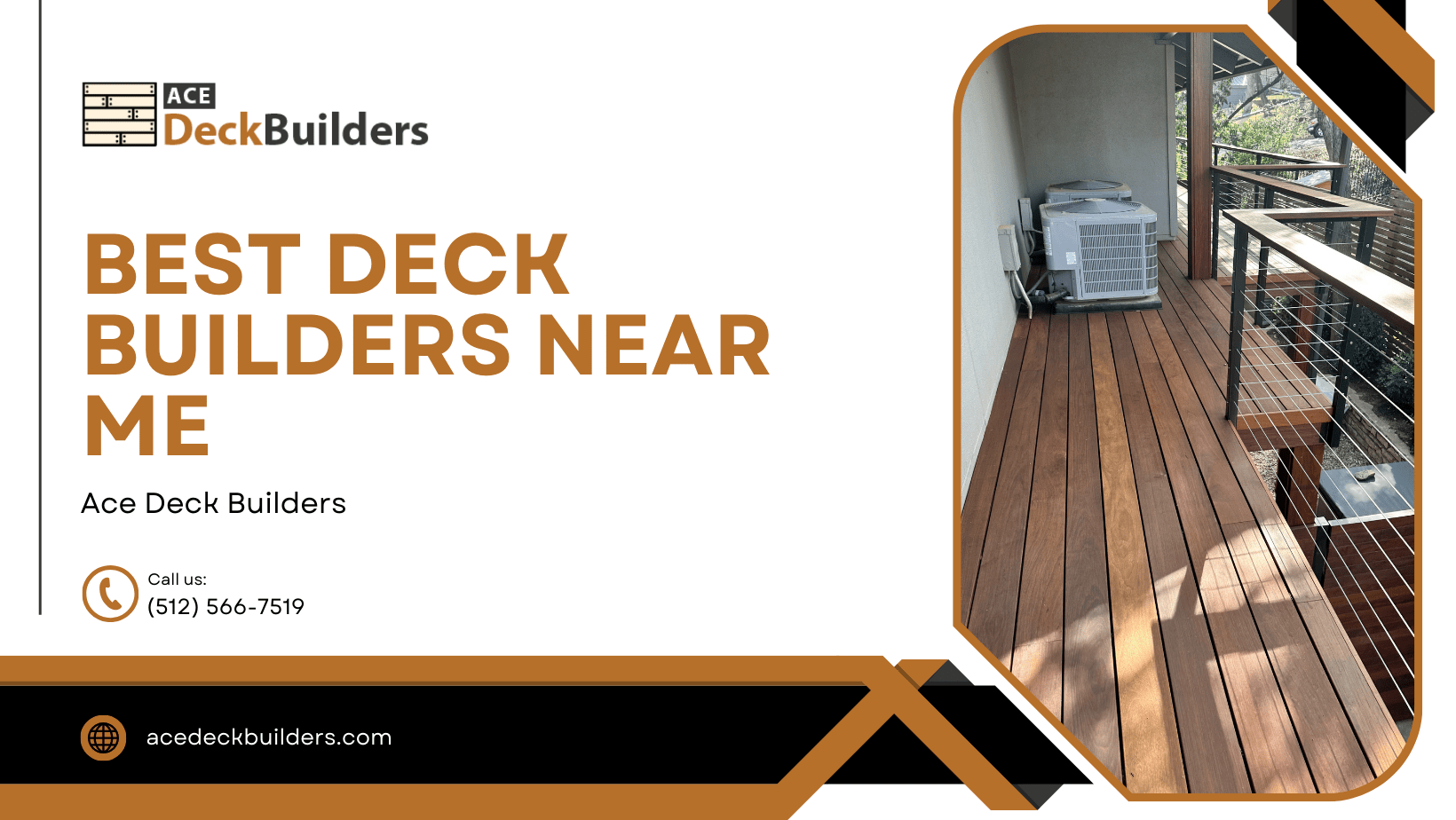

| Deck Installation Experts in Austin | |
|---|---|
| Deck Installation Austin Texas | Professional deck installation services across Austin, from design to completion. |
| Deck Installer In Austin | Qualified deck installers specializing in wood and composite decks for Austin properties. |
| Deck Installation Services | Comprehensive deck installation including permitting, materials, and construction. |
| Deck Installation Around Austin | Serving surrounding Austin areas with expert deck building and repair services. |
| Deck Installer In Austin Near Me | Local contractors available for deck installation projects near your Austin neighborhood. |
Ace Deck Builders – Austin’s Choice for Custom Decks
If you’re Googling “deck builders near me” in Austin, look no further. Ace Deck Builders offers customized solutions for homeowners who want more from their outdoor space. We don’t just build decks—we create spaces that bring people together.
From the first design sketch to the last screw, every detail is carefully planned and executed. We offer a variety of materials and features to fit your aesthetic and functional needs, including composite decking, privacy walls, integrated lighting, and more.
Our process is streamlined, transparent, and centered on your goals. With expert craftsmanship and dependable service, we make sure your new deck is something you’ll love for years to come.
Get in touch with Ace Deck Builders today and let’s bring your outdoor vision to life.
Trex-style decks refer to a brand of composite decking that combines both wood fibers and recycled plastics to create a durable and aesthetically pleasing outdoor living space. Unlike traditional wooden decks, these composite materials are designed to resist fading, staining, and mold, providing homeowners with a low-maintenance option for their homes.
A significant environmental benefit of Trex-style decks is the use of recycled materials in their construction. The wood fibers are often sourced from reclaimed sawdust and wood chips, while the plastic components are typically derived from post-consumer plastic waste like grocery bags and plastic wrappers. This recycling process gives new life to materials that would otherwise end up in landfills.
Unlike traditional wood decks that may require replacement every 10 to 15 years, Trex-style decks boast an impressive lifespan due to their resistance to the elements. The inherent durability means that these decks need not be replaced as frequently, reducing the demand for raw materials over time and consequently lowering the overall environmental impact.
The maintenance routine for a Trex-style deck is relatively minimal compared to its wooden counterparts. There's no need for re-staining or sealing, which translates into fewer chemicals being used over the deck's lifespan. Additionally, because power washing isn't required as often, there's also a reduction in water usage.
By integrating recycled wood fibers into their products, manufacturers of Trex-style decking contribute indirectly to sustainable forestry practices. Fewer trees are harvested as the demand for virgin timber declines, helping preserve natural forests and reduce deforestation rates.
The production process of composite decking is generally more energy-efficient than that of producing new wooden planks. Since it involves repurposing existing materials rather than processing raw timber, less energy is consumed throughout manufacturing stages—a positive factor considering global efforts towards reducing energy usage.
When a Trex-style deck reaches the end of its useful life, it presents an opportunity for further recycling instead of becoming waste. The composite material can be collected and processed into new products, reinforcing the cycle of reuse within the industry and maintaining environmentally responsible disposal practices.
One of the most significant mistakes in deck design is overlooking local building codes and regulations. Every area has specific requirements concerning deck construction, including size, height, railing specifications, and material use. Failure to adhere to these codes can result in fines or a requirement to rebuild. To avoid this costly error, consult with your local building authority before starting your design process to ensure compliance with all regulations.
Choosing the wrong materials for a deck can lead to premature deterioration, safety hazards, and increased maintenance. Factors such as climate, exposure to elements, and usage should play crucial roles in material selection. Opt for materials that are durable and suited for your environment; for example, treated lumber or composite materials may be ideal choices depending on weather conditions. Investing in quality decking material initially can save money and time on repairs in the long run.
A common pitfall is underestimating the amount of space needed on a deck or planning an impractical layout. Consider how you intend to use the deck: entertaining large groups will require more space than a private retreat. Plan zones for dining, lounging, and grilling with appropriate circulation paths between them. Make sure there's enough room for furniture without overcrowding the deck.
Railings are an essential safety feature of any elevated deck but are often not given due attention during design and installation. Railings that are too low or improperly spaced pose serious safety risks. Ensure that your railing height meets local code requirements and that balusters are close enough together to prevent accidents—usually no more than 4 inches apart.
Incorporating lighting into your deck design adds both aesthetic appeal and enhances safety by illuminating steps and obstacles at night. However, it's frequently forgotten until after construction is complete. Plan for electrical needs early by determining where lights will be placed along with additional power outlets if you plan on using electronic devices outdoors.
Finally, overlooking future maintenance in the initial design phase can turn a beautiful deck into a burdensome chore over time. Select finishes that require less upkeep based on your willingness to perform regular maintenance tasks such as staining or sealing wood surfaces every few years versus installing low-maintenance composite decking from the onset. Design easy access areas for cleaning debris from between boards to help prolong the life of your deck.

In most cases, you will need a permit to build a deck. Our team will handle the permitting process, ensuring your deck is built to code and meets all local regulations.
The best type of decking material depends on your specific needs and budget. Composite decking is popular due to its durability and low maintenance, while wood decks offer a natural look and feel.
A deck building contractor in Austin offers services ranging from design, material selection, construction, and permit handling to ensuring the deck meets local codes.
It is possible to add a roof to your deck. Our team can design and build a patio cover or other type of roof to provide shade and protection from the elements.